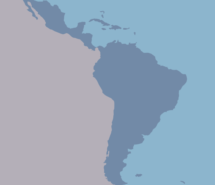Posted on 14 Jun 2016
The geography of criminal power is a physical manifestation – a location in time and space – where criminal influence can be visibly witnessed, and a lens through which it can be analysed. In Tijuana, a border city in Baja California in Mexico, criminal power is embodied by the way that real estate influenced by the criminality or the criminal actors.
The advantage of applying this methodological tool is that we have detailed information on the city and its different actors, whether individuals or companies, whether white-collar criminals or blue collar. Unlike mathematical models – which of course are relevant to measure the extent of laundering through financial systems – this methodology allows us to make approximations of the value of the real estate, the type of property invested, and the most influence areas by the criminal economy.
Mapping criminal power allows us to establish that there is indeed a geography of class power, it is of greater public interest to know more about the socio-economic effects of certain dynamics, such as gentrification, in Tijuana´s society. There are additional insights that alter many aspects of Tijuana; however due to the limited amount of research undertaken until now, a more extensive mapping of Mexico’s middle range cities is one of the desired avenues for future research.
The geography of criminal power in Tijuana, Mexico (2000-2010)
 The route of money laundering can be established from the main street that connects the city of Tijuana with Mexicali, the capital of the state of Baja California, and followed turning inwards to the rest of the country. Whilst the connection between Tijuana – Mexicali and Tijuana – Ensenada, a wine industry community, exists since the 19th Century, General Abelardo Luján Rodriguez, General Governor of the Baja California Norte territory (1923 -1930), was one of the first social actor beginning to smuggle opium via Mexicali, early in the 20th Century.
The route of money laundering can be established from the main street that connects the city of Tijuana with Mexicali, the capital of the state of Baja California, and followed turning inwards to the rest of the country. Whilst the connection between Tijuana – Mexicali and Tijuana – Ensenada, a wine industry community, exists since the 19th Century, General Abelardo Luján Rodriguez, General Governor of the Baja California Norte territory (1923 -1930), was one of the first social actor beginning to smuggle opium via Mexicali, early in the 20th Century.
Approximately ten per cent of Tijuana´s surface area was influenced by illegal proceeds through multiple actors that make up the criminal field, between 2000 and 2010. Ejidos, private suburbs, dwellings, apartments, gyms, office buildings, hotels, warehouses, ranches, and recreational buildings are some of the examples of where the criminality invest the dirty money.
Most of the money was invested in recreational areas and dwellings. It was assumed that the upper class usually does not own residences with a market value exceeding the US$ 300,000. However, research found residences close to US$ 500,000 (66 per cent more than the upper class economic capacity) and above, which were about 800 square meters of construction, and more than 1,000 meters for the garden area. Very quickly, the neighbourhoods detect during the research, that the Real Estate prices soared with no apparent reason were: Del Rio Anaxa, Murua, Alamar, La Escondida, Residencial Isla Cedros, Lomas de Real, Lomas de Agua Caliente, Colined de Chaputepec, Caleta, Lomas del Rubi, La Sierra, Cumbres del Rubi, San Antonio del Mar, Baja Malbu and Real de Mar.
In some of these neighbourhoods, we find that the square meter of construction spiked from US$ 1,300 to US$ 9,000 or even US$ 42,000 dollars – a staggering increase. During 2010, the most expensive home registered in the study was worth US$ 15 million. Obviously, these prices go far beyond the economic capacity of the upper class.
When interviewing an architect, he reported that such kinds of high-value properties along with multiple luxury cars could possibly be owned only by a famous plastic surgeon who earns a substantial salary in US dollars, and lives in a devaluated pesos economy. Yet, it does not quite work like that; in fact, is the other way around. Aree there that many plastic surgeons working in the United States but living in Tijuana? Why should a surgeon and his family live in Mexico when they can have access to the high living standards and benefits found in the United States? Similar kinds of investment could be done in any U.S. elite neighbourhood, having in mind that the average house in Tijuana in 2010, was worth about US$ 50,000.
The geography of criminal power as a new field of knowledge
I decided to undertake a craft investigation, with an applied methodology that invariably resorted to field work, community documented knowledge, selective interviews, as well as mapping information. This has been a very interesting experience because it enabled me to rebuild the city and the influence of criminal economy in the real estate sector in Tijuana during the most violent period, between 2000 – 2010 – through the lens of a lawyer, a doctor, a victim of kidnapping, a son of a drug lord, and an architect.
 Among the results, criminal actors can be categorised in five different “levels” that do not necessarily correlate with each other. The higher the level an actor is located at, the greater his impact on society, by managing international criminal practices, amongst others high-impact crimes, highlighted in the case of Tijuana, for tax evasion and then money laundering. It has been detected that the illicit profits flow from Tijuana to the United States (San Diego and Miami), as well as Switzerland and Luxembourg.
Among the results, criminal actors can be categorised in five different “levels” that do not necessarily correlate with each other. The higher the level an actor is located at, the greater his impact on society, by managing international criminal practices, amongst others high-impact crimes, highlighted in the case of Tijuana, for tax evasion and then money laundering. It has been detected that the illicit profits flow from Tijuana to the United States (San Diego and Miami), as well as Switzerland and Luxembourg.
While level 1 is a larger area and spread compared to the upper levels, the actors located at lower levels commit crimes more spontaneously and without incurring in any high-impact crimes (i.e. homicides, kidnapping, and burglary). The criminal economy influence in the real estates in Tijuana takes place mainly in the levels 2 to 5.
Academic contributions creating a new field of research
In the Summer of 2013, I had the opportunity to read the specialised books of Brigitte Unger (Professor at the Utrecht University School of Economics), most notably Money Laundering in the Real Estate Sector (Unger, Brigitte and Joras Ferwerda, 2011, p.162). Parallel to her work, I read with multidisciplinary lenses The limits of Capital (2011) of David Harvey (Professor at City University of New York and Miliband Fellow at the London School of Economics). Somehow I sensed that Harvey´s concepts could be partially taken into the analysis of the criminal economy influence in the Real Estates of Northwestern Mexico. I felt the urge to contribute empirically to the important debate that was leading Unger, through economic models applied to Australia and The Netherlands.
Unger´s contributions, and other specialists as Joras Ferwerda, Daan van der Linde and John Walker himself, are highly relevant to start shaping the illicit economic resources studies. I emphasize the word shape, because this is really a new field of knowledge: both geographically dispersed and full of niche opportunities, flexible according to the circumstances, and – in most cases – it is a discrete operation to which it is not followed up, either from the public or the private sector.
Those with experience in the financial sector and financial services particularly know that these crimes are often too complex to detect – and even trickier to follow up with operations with illegal proceeds. White-collar criminals have in favour 1) access to technology, 2) financial resources, 3) loyal personnel, and of course 4) the surprise factor. Opposing them, authorities often lack thereof and struggle with 1) a lack of trained and updated personnel, 2) delayed intelligence work, 3) the urge to ask for international cooperation, and most importantly 4) the unknown location of the central actors linked to money laundering.
In that sense, usually when the police starts a criminal investigation, the criminal actors involved already introduced the illegitimate money into the financial system or changed the resource to another bank account with an international destination. Charting the moment of criminal power offers an alternative means by which to understand and anticipate the dynamics and influence of criminal groups.
The original article has been written by Zulia Orozco Reynoso, Global Initiative Network Member, Professor at the Autonomous University of Baja California, and researcher for Justice in Mexico, Programme of the University of San Diego. Her article has been made available through the ECPR Standing Group on Organised Crime newsletter June 2016, Volume 13, Issue 2.



